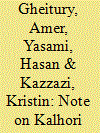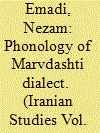| Srl | Item |
| 1 |
ID:
179392


|
|
|
|
|
| Summary/Abstract |
The topic of “Endangered Languages” has come more into the focus of public and academic debate in recent years and is being discussed by numerous scholars. The Iranian languages are a branch of the Indo-Iranian languages, which are in turn a branch of the Indo-European language family. As of 2008, there were an estimated 150 to 200 million native speakers of Iranian languages.1 The Ethnologue (2019)2 estimates that there are eighty-six Iranian languages; the most prominent of these are Persian, Pashto, Balochi and the Kurdish group.
|
|
|
|
|
|
|
|
|
|
|
|
|
|
|
|
| 2 |
ID:
179393


|
|
|
|
|
| Summary/Abstract |
This paper describes and analyzes data from a number of Modern Iranian dialects spoken in Khorasan in the east of Iran which are unusual among the other Western Iranian languages in that they have grammaticalized a split tense-sensitive alignment in indexation, compared to other Iranian languages whose indexation splitness is sensitive to both tense and transitivity. These dialects are the former dialect of Birjand in the late nineteenth and early twentieth century, the present-day dialect of Ferdows, Khanik, and Se-Ghal’e. The findings are put in the context of the available data from the Classical Persian texts to show that the tense-sensitive splitness mentioned above is traceable in those texts. A number of external factors are discussed which seem to have been influential in the restructuring of the split-alignment of the former dialect of Birjand into a uniformly nominative-accusative alignment in terms of indexation as observed in the present-day dialect of Birjand. It is proposed that this restructuring is an instance of simplification. The three other dialects cited above are endangered in the sense that they can undergo the same kind of restructuring as happened to the dialect of Birjand.
|
|
|
|
|
|
|
|
|
|
|
|
|
|
|
|
| 3 |
ID:
168978


|
|
|
|
|
| Summary/Abstract |
Located in the Caspian forest south of the capital city of Sāri in Mazandaran, the rural district of Kalijān Rostāq is home to a number of close-knit villages which share a local Mazandarani dialect. The vernacular offers some authentic features in phonology, morphology, and lexis that are otherwise lost in the urban variety spoken in Sāri due to contact with Persian. In an attempt to elucidate on the loosely-known aspects of the Mazandarani language, this study offers a sketch grammar of the dialect of Kalijān Rostāq with a view to typological features. The glossary that follows includes many Caspian cultural items that are already moribund in the language.
|
|
|
|
|
|
|
|
|
|
|
|
|
|
|
|
| 4 |
ID:
098436


|
|
|
|
|
| Publication |
2010.
|
| Summary/Abstract |
Despite the great number of studies conducted by Western scholars exploring kinship terminologies in different languages, there seems to have been little attempt at dealing with kin words in Iranian languages like Kurdish. More specifically, Kalhori, as a southern dialect of Kurdish, has rarely been subject to studies of this nature. Underlining the significance of such studies in the wider linguistic and anthropological contexts, this study attempts to explore kin words Kalhori speakers use to refer to or address their relatives. We also make an attempt to investigate the possibility of presenting a formal explanation of the terms by placing them in a componential analysis framework.
|
|
|
|
|
|
|
|
|
|
|
|
|
|
|
|
| 5 |
ID:
144721


|
|
|
|
|
| Summary/Abstract |
Phonology is one of several aspects of a natural language and it is the study of sound systems of languages. The purpose of this article is to study and describe the phonemic system of the dialect of Marvdashti. Marvdashti dialect belongs to the southwestern branch of New Iranian languages. The article deals with an inventory of Marvdashti dialect sounds and their features and it covers the phonological rules which specify how sounds interact with each other. This study first introduces and examines the consonants and vowels of Marvdashti dialect, and then explores phoneme arrangement, syllable structure and phonological processes such as assimilation, dissimilation, alteration, epenthesis, deletion and methathesis.
|
|
|
|
|
|
|
|
|
|
|
|
|
|
|
|